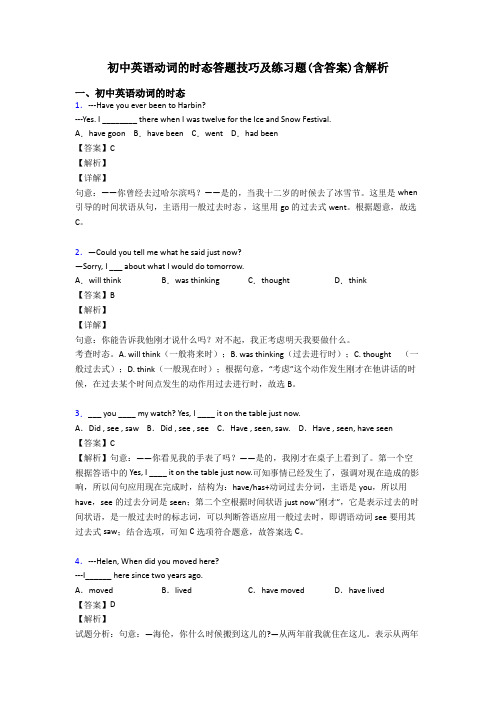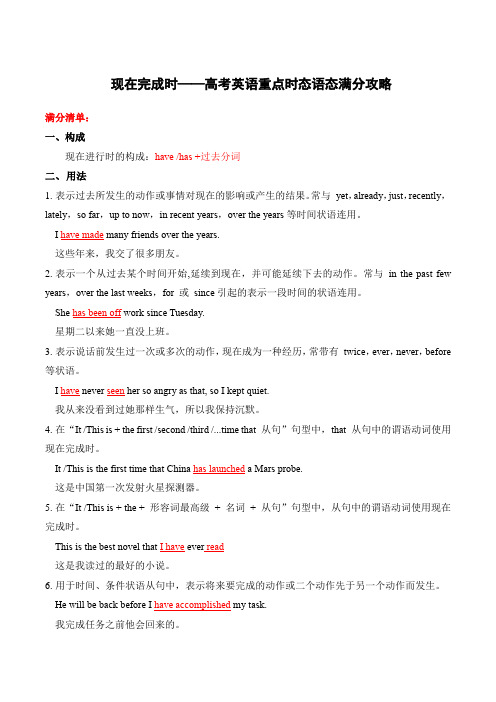时态的常考点及难点
时态混合:一般现在、一般过去和一般将来时、现在进行时(教师版)

知识图谱一般现在时知识精讲一、一般现在时表示通常性、规律性、习惯性、真理性的状态或者动作有时间规律发生的事件的一种时间状态。
二、句子结构主语(第一/二人称/第三人称复数)+do (动词原形)主语(第三人称单数)+does (动词三单形式)主语+am/ is /are用法示例表示经常性或习惯性的动作We get up at six every morning.我们每天早上六点钟起床。
表示现在的状态、能力、性格Mr. Wang writes good English but he doesn’t speak well.王先生的英文写得很好但他说不好。
表示格言或警句Pride goes before a fall.骄者必败。
表示永恒的客观真理The earth moves around the sun.地球绕着太阳转。
四、时间状语1. 表示频率的副词: always, usually, often, sometimes, never, hardly, seldom…2. every/once+名词: every day/ week/ year, once a week/ month …3. 表示时间的短语: twice a day, on weekends, on Mondays…情况变形示例一般情况加-s help-helps play-plays以辅音字母+o结尾加-es go-goes do-does以x, sh, ch, s结尾加-es teach-teaches brush-brushes以辅音字母+y结尾变y为i加es study-studies try-tries特殊情况没有统一的规则have-has; be-isbe动词行为动词用法我是am你是are;is跟着他/她/它;复数都用are。
主语是第三人称单数外,都用动词原形;主语是第三人称单数时,动词词尾加-s或-es。
肯定式I am a student.我是一名学生。
备战2023年高考英语一轮复习考点帮(全国通用)考点 09 完成体-谓语动词时态 (解析版)

考点09 完成体谓语动词时态是语篇型填空和短文改错的必考点和热点。
高考对谓语动词的考查一时态为住,语态为辅。
对于时态的考查主要集中在一般现在时,一般过去时、现在完成时等等常见时态。
此外在考查物动词的同时还考查主谓一致问题。
预计2023年时态仍将是高考的重点和难点所在。
高考主要以语法填空、短文改错等形式考查,动词的时态在语法填空和短文改错中既是必考点又是热点。
高考在考查时态的同时,仍然以最基本的时态(一般现在时,一般过去时、现在完成时)为主,但是也会兼顾其他语法内容的考查,比如各种从句、强调句、倒装句等,其交叉式和复合式的特点尤为明显。
1.了解并能正确运用必考的10种时态(一般现在时、一般过去时、一般将来时、现在进行时、过去进行时、过去将来时、将来进行时、现在完成时、过去完成时、现在完成进行时);2. 熟练运用一般现在时、一般过去时、现在完成时等高考高频时态;3. 掌握几种易混时态的区别,如现在完成时和一般过去时等。
完成体考向一、现在完成时1. 现在完成时结构:主语+ 助动词have(has) + 动词过去分词否定句:have/has后加not, haven’t/hasn’t一般疑问句:have/has提前2. 现在完成时的用法:(1)表示过去发生的某一动作对现在造成的影响或产生的结果,强调的是这个结果或影响,常与yet,already,just,before,lately等时间状语连用。
—Have you had your lunch yet? 你吃过午饭了吗?—Yes, I have. I have just had it. 是的,我刚吃过。
(现在我不饿了。
)I have already posted the photos. 我已经寄过这些照片了。
(这些照片已不在我这里了。
)have(has) gone to,have(has) been to和have(has) been in的区别1. have (has) gone to表示"已经去某地了",不能与for+一段时间连用。
专升本-英语时态考点整理

四. 一般将来时
表示将来某时间要发生的事或存在的状态,也可表示 将来经常或反复发生的动作,常与表示将来的时间状 语连用。表示方法多样: 1. will\shall do 将来的动作或状态 2. be going to do 最近打算要做的事或可能要发生 的事 3. be to do 必须按计划要进行的 4. be about to do 即将发生(不加将来的时间状语) 5. be doing (常与arrive, leave, come, start)
三. 一般过去时
常与以下时间状语连用:an hour ago, the other day, in 1987,last year... , just now, in those days 等。 表示:过去某个时间发生或存在的动作、过去经 常发生或偶尔发生的动作。
常见考点如下: 1. 在It is time that...(某人该做某事了)的that 从句中的谓语动词用过去时。E.g. It is time that you went to bed.= It is time for you to go to bed. 2. 注意区分used to do (过去常做)和 get\be\become used to doing sth. (习惯于做 某事) (20005) My sister is used to _______ with all the windows open. A. sleep B. have slept C. sleeping D. Slept
七.过去进行时
表示过去某时刻正在进行的动作。 与always, constantly,forever等状语连用时带有感情 色彩,如:She was always finding fault with me. 她总是挑我的毛病。Biblioteka Grammar Test 1
过去进行时——高考英语重点时态语态满分攻略

过去进行时——高考英语重点时态语态满分攻略满分清单:一、构成过去进行时的构成:was /were + 现在分词二、用法1.表示过去某一时刻或某一段时间内正在进行的动作,常有表过去时间的状语(从句)。
She was watching TV at six yesterday evening.昨晚6点她正在看电视。
He was reading a novel when I came in.当我进来时,他正在看小说。
2.表示过去某段时间内持续进行的动作。
(常常用的时间状语有this morning,the whole morning,all day,from nine to ten等。
)We were watching TV from seven to nine last night.昨天晚上七点到九点我们在看电视。
3.表示过去计划好或安排好的将来动作(只限于come,go,leave,arrive,start,move,sail,fly,travel,stay等)。
He said she was arriving the next day.他说她将第二天到达。
4.与always,forever,constantly,continually连用,表示赞赏或厌恶等感情色彩。
Comrade Lei Feng was always thinking of others. He never thought of himself first.雷锋同志总是先想着他人,而不是他自己。
(赞扬)三、被动语态的构成过去进行时的被动语态:was /were + being + doneMy bike was being repaired at that time.当时我的自行车正在修理。
满分练习:1. I________ the photos on the noticeboard when I heard a voice behind me.A. looked atB. was looking atC. had looked atD. would look at2. My parents _______ dumplings when I got home yesterday afternoon.A. have been makingB. are makingC. will be makingD. were making3. I advised you to find out when the plane ______ at the booking office.A. was taking offB. is taking offC. takes offD. has taken off4. When I arrived, Maria ________, so we only had time for a few words.A. had just leftB. has just leftC. just leftD. was just leaving5. Unfortunately, when I dropped in, Professor Smith ________, so we only had time for a few words.A. has just leftB. had just leftC. just leftD. was just leaving6. —No one answered when I phoned this morning. Where were you?—I ________ for teeth in the dental clinic.A. was being treatedB. have been treatedC. was treatedD. treated7. She hurriedly ran home, never once looking back to see whether she ________.A. would followB. was followingC. has followedD. was being followed8. When entering the room, I saw that the TV ________.A. fixedB. had fixedC. was being fixedD. was fixing9. I didn't know a thing about the Clean Air Act that ______ in congress at that time.A. was being debatedB. was debatedC. had been debatedD. debated10. —Have the workers got our roof repaired?—I don't know. But it _________ when I called them yesterday.A. was repairingB. was repairedC. had repairedD. was being repaired11. The first time I saw Jenny, she _____ (talk) to some students at the English Corner.12. I ___________ (sleep) when there was a knock at the door.13. The farmers __________ (pick) apples when I saw them.14. I remember well that the witness ______ (question) by a journalist at that time.15. The doctor told us that the elderly man _____ (treat) for kidney failure.答案以及解析1. 答案:B解析:考查过去进行时。
初中英语动词的时态答题技巧及练习题(含答案)含解析

初中英语动词的时态答题技巧及练习题(含答案)含解析一、初中英语动词的时态1.---Have you ever been to Harbin?---Yes. I ________ there when I was twelve for the Ice and Snow Festival.A.have goon B.have been C.went D.had been【答案】C【解析】【详解】句意:——你曾经去过哈尔滨吗?——是的,当我十二岁的时候去了冰雪节。
这里是when 引导的时间状语从句,主语用一般过去时态,这里用go的过去式went。
根据题意,故选C。
2.—Could you tell me what he said just now?—Sorry, I ___ about what I would do tomorrow.A.will think B.was thinking C.thought D.think【答案】B【解析】【详解】句意:你能告诉我他刚才说什么吗?对不起,我正考虑明天我要做什么。
考查时态。
A. will think(一般将来时);B. was thinking(过去进行时);C. thought (一般过去式);D. think(一般现在时);根据句意,“考虑”这个动作发生刚才在他讲话的时候,在过去某个时间点发生的动作用过去进行时,故选B。
3.___ you ____ my watch? Yes, I ____ it on the table just now.A.Did , see , saw B.Did , see , see C.Have , seen, saw. D.Have , seen, have seen【答案】C【解析】句意:——你看见我的手表了吗?——是的,我刚才在桌子上看到了。
第一个空根据答语中的Yes, I ____ it on the table just now.可知事情已经发生了,强调对现在造成的影响,所以问句应用现在完成时,结构为:have/has+动词过去分词,主语是you,所以用have,see的过去分词是seen;第二个空根据时间状语just now“刚才”,它是表示过去的时间状语,是一般过去时的标志词,可以判断答语应用一般过去时,即谓语动词see要用其过去式saw;结合选项,可知C选项符合题意,故答案选C。
现在完成时——高考英语重点时态语态满分攻略

现在完成时——高考英语重点时态语态满分攻略满分清单:一、构成现在进行时的构成:have /has +过去分词二、用法1.表示过去所发生的动作或事情对现在的影响或产生的结果。
常与yet,already,just,recently,lately,so far,up to now,in recent years,over the years等时间状语连用。
I have made many friends over the years.这些年来,我交了很多朋友。
2.表示一个从过去某个时间开始,延续到现在,并可能延续下去的动作。
常与in the past few years,over the last weeks,for 或since引起的表示一段时间的状语连用。
She has been off work since Tuesday.星期二以来她一直没上班。
3.表示说话前发生过一次或多次的动作,现在成为一种经历,常带有twice,ever,never,before 等状语。
I have never seen her so angry as that, so I kept quiet.我从来没看到过她那样生气,所以我保持沉默。
4.在“It /This is + the first /second /third /...time that 从句”句型中,that 从句中的谓语动词使用现在完成时。
It /This is the first time that China has launched a Mars probe.这是中国第一次发射火星探测器。
5.在“It /This is + the + 形容词最高级+ 名词+ 从句”句型中,从句中的谓语动词使用现在完成时。
This is the best novel that I have ever read这是我读过的最好的小说。
6.用于时间、条件状语从句中,表示将来要完成的动作或二个动作先于另一个动作而发生。
现在完成时专题讲解

现在完成时专题讲解现在完成时态专题讲解一、注意理解时态的两层意义及不同意义对应的标志词观察一:请仔细观察下列句子。
1.I have already finished reading the book.(现在我了解了书的内容).2.Have you had lunch yet? Yes, I have.(我现在不饿了).3.He has never seen the film before. (现在他不了解电影的内容)4.I have just washed my car.(现在车很干净了)5.I have seen the film three times. (我现在了解电影的内容)思考一:现在完成时表达的含义:1)表示在发生或已经结束的动作对造成的影响或结果标志词:常与already(已经),yet(已经),just(刚刚),before,ever(曾经),never,three times等词连用。
常用于肯定句中, 常用于否定句,疑问句句尾。
练习、翻译以下句子1、你已经找到你的书了吗? (find-found your book)2、他们已经在这个城市建了许多房子. (build-built many buildings)3、Judy还刚到达. (arrive-arrived)观察二:请仔细观察以下句子1.We have been in Qi Bin Middle School since 2013.(我们还在淇滨中学)2.He has learned English for 5 years/since 5 years ago/sinceI was in primary school.(他还在继续学习英语)3.China has made great changes these years/up to now/so far.(现在还在发生变化)思考二:现在完成时表达的含义:2)表示在过去已经开始并到现在。
高考英语语法_时态易混点

Who Is the Laziest?
Father: Well, Tom, I asked your teacher today, and now I want to ask you a question. Who is the laziest person in your class?
Tom: I don't know, Father. Father: Oh, yes, you do! Think! When the other boys and girls are reading and writing, who sits in class and only watches how the other people work? Tom: Our teacher, father.
always; usually; often; sometimes, every day/week/year…
一般现在时态常见考点:
1. I __________ am (be) a student.
2. He with his brothers often __________(fly) kites after flies school .
Father: You know, Tom, when Lincoln was ___(be) your age, he was ___(be) a very good pupil. In fact, hewas ___(be) the best pupil in his class.
know (know) that. But when Tom: Yes, Father. I ____ was (be) President of he was ____(be) your age, he____ the United States.
- 1、下载文档前请自行甄别文档内容的完整性,平台不提供额外的编辑、内容补充、找答案等附加服务。
- 2、"仅部分预览"的文档,不可在线预览部分如存在完整性等问题,可反馈申请退款(可完整预览的文档不适用该条件!)。
- 3、如文档侵犯您的权益,请联系客服反馈,我们会尽快为您处理(人工客服工作时间:9:00-18:30)。
1 时 态 的 常 考 点 及 难 点 常考时态: 1. 一般现在时:(与一般现在时连用的时间状语有:often , frequently, at times , usually, sometimes, always, seldom, twice a week, every day ) 表示经常性或习惯性动作、状态、性能,表示主语的特征、能力、性格等,表示客观事物或普遍真理。 eg:He gets up at six every day eg:He works hard. eg:The sun rises in the east. 一般现在时表将来: 1)come, go, arrive, leave, fly ,start, begin, end, return, set out, take off等动词常用一般现在时代替将来时,表示一个按规定、计划或安排要发生的动作。The train leaves at six tomorrow morning. 2)在时间状语从句、条件状语从句、让步状语从句中常用一般现在时代替将来时。但要注意由if 引导的条件状语从句中可以用shall或will表“意愿”,但不表示时态。 When Bill comes (不是will come), ask him to wait for me. I'll write to you as soon as I arrive there. The more we get together , the happier we will be.
2. 现在进行时 (now ,at present ,these days) 1)表示渐变的动词有:get, grow, become, turn, run, go, begin等。可译作“越来越…;渐渐”。 The leaves are turning red. It's getting warmer and warmer. 2) 与always, constantly, forever, often, all the time等词连用,表示反复发生的动作或持续存在的状态,往往带有说话人的很强烈的感情色彩,表示赞叹、抱怨、生气或者不耐烦等。 You are always changing your mind. 3)现在进行时可以表示短暂的将来,表示即将发生的或预定中计划好的活动。 Are you staying with us this weekend? 这周和我们一起度周末吗? We are leaving soon. 我们马上就走。 I have been working on this project the whole morning.我一早上都一直在忙这个计划。 4.)be doing sth ---- when ---
3. 一般将来时 (常用时间标志: one day,some day, next time /week / month / year,tomorrow, from now on,later,before long,soon,sometime in the future,in the future,in the year to come,in the following day / week / month / year,in a few days’ time, in a month等等。) ① be going to do 表将来时态:常表示打算准备做某事,或表示可能要发生或肯定要发生的事情。 eg:What are you going to do this evening? eg:It’s going to rain. ② be doing表将来时态:只限于某些动词,如:go,leave,start,finish等非延续性动词 的进行时表示将来时,表示短暂的按计划安排要发生的事。 eg: I am finishing my work. He is coming. They are leaving for Tibet. ③ be to do表将来时态:用于表示吩咐、命令、约定、计划中的或按职业义务、要求等等 即将发生的动作。 eg: The medicine is to be taken three times a day. ④ be about to do sth --- when --- 或be on the point of doing sth. when… 2
表将来时态,意思是“就要…正要…”。在这种情况下一般不可与具体的 时间状语连用。 eg:We were about to leave, when it started to rain.我们正要离开,天突然下雨了。
4. 现在完成时 一种是动作发生在过去, 动作不延续, 但对现在有结果和影响。另一种是动作从过去开始一直延续到现在, 对现在有结果和影响, 现在完成时常与lately,recently,so far ,already,those days,ever,just,up to now during / in /over the last(past)few years (months, weeks)、in recent years等表示时间的副词或时间短语连用,也可与since, for引导的表示一段时间的时间状语连用(有时for省略),但是这不等于说for时间短语就一定得用完成时。 1)下列句型中常用现在完成时 It is (has been) + 一段时间 + since从句 It/ This / That is the first / second time…. that sb. has done sth…(这是某人第…次做…)结构中的从句部分,用现在完成时。 对比:It was the third time that the boy had been late. 2.)“It /That/This is + 最高级修饰的先行词 + 定语从句”中的定语从句中常用现在完成时。 This is the first time (that) I've heard him sing. 这是我第一次听他唱歌。 This is the best film that I've (ever) seen. 这是我看过的最好的电影。 对比:I have never seen a better film before. 我以前从未看过比这个更好的电影 3)完成时态可以和否定的比较级连用,表示最高级。 I have never seen a better film. 我没看过一部比这更好的电影。 对比:I have never seen him before.我以前从未见过他。
一般过去与现在完成时的区别: 一般过去时所发生的动作只指在过去,与现在无关。而现在完成时指的是从过去某一时间开始,一直持续或影响到现在。如: I worked here for ten years. 我在这里工作过十年。(现在不在那里工作了) I have worked here for ten years.我在这里已工作了十年了。(从开始到现在已十年了,并且现在还在这里工作) 4. 过去完成时 1)在by、by the end、by the time、until、before、since后接表示过去某一时间的短语或从句以前发生的动作。如:By the end of last year, we had produced 20,000 cars. The train had left before we reached the station. 2)表示曾实现的希望、打算、意图、诺言等。常用had hoped / planned / meant / intended/though / wanted / expected等或用上述动词过去式接不定式完成式表示即:hoped / planned … + to have done。 3)表示“一……就”的几个句型: Hardly had + 主语 + 过去分词 + when Scarcely had+ 主语 + 过去分词 + when No sooner had + 主语 + 过去分词than before + 一般过去时。 had just done ---- when --- 如:We had no sooner been seated than the bus started. = No sooner had we 3
been seated than the bus started. ②在before或after引导的时间状语从句中用一般过去时态代替过去完成时。 After he (had)left the room, the boss came in. We arrived home before it snowed.
5将来完成时 (常与将来完成时连用的时间状语有:by ,by the end of +将来时间,by this time ,by the time +从句(一般现在时)等) 表示在将来某一时间之前完成的动作。如: 1) By the end of next month, we shall have learned 100 texts . 2) We will have built the bridge by the time he comes back next year . 3) By this time tomorrow ,I shall have finished my work .
Ⅱ被动语态 1)短语动词变被动语态时,勿要掉“尾巴”。 The children were taken good care of (by her). Your pronunciation and spelling should be paid attention to. 2)有些动词以其主动形式表示被动意义,特别是当主语是物时,常见的动词有sell、write、wear,wash、open、lock等。 3)在“be + 形容词 + to do”中,不定式的逻辑宾语是句子的主语,用主动代被动。 This kind of water isn’t fit to drink. The girl isn’t easy to get along with. 4)be to blame(受谴责),be to rent(出租)也用主动形式表被动 5)被动形式表示主动意义的几种情况。 be seated坐着 be hidden躲藏 be lost迷路 be drunk喝醉 be dressed穿着
